Microwave Heating Healing of Asphalt Mixture with Coal Gangue Powder and Basalt Aggregate
Abstract
:1. Introduction
2. Materials and Methods
2.1. Asphalt and Aggregate
2.2. Fillers
2.3. Asphalt Mixture Proportioning Design
2.4. Experimental Methods
2.4.1. Chemical Composition Analysis
2.4.2. Stability of Asphalt Mixtures
- is the residual Marshall stability of specimens (%),
- is the standard Marshall stability of specimens (kN), and
- is the immersion Marshall stability of specimens (kN)
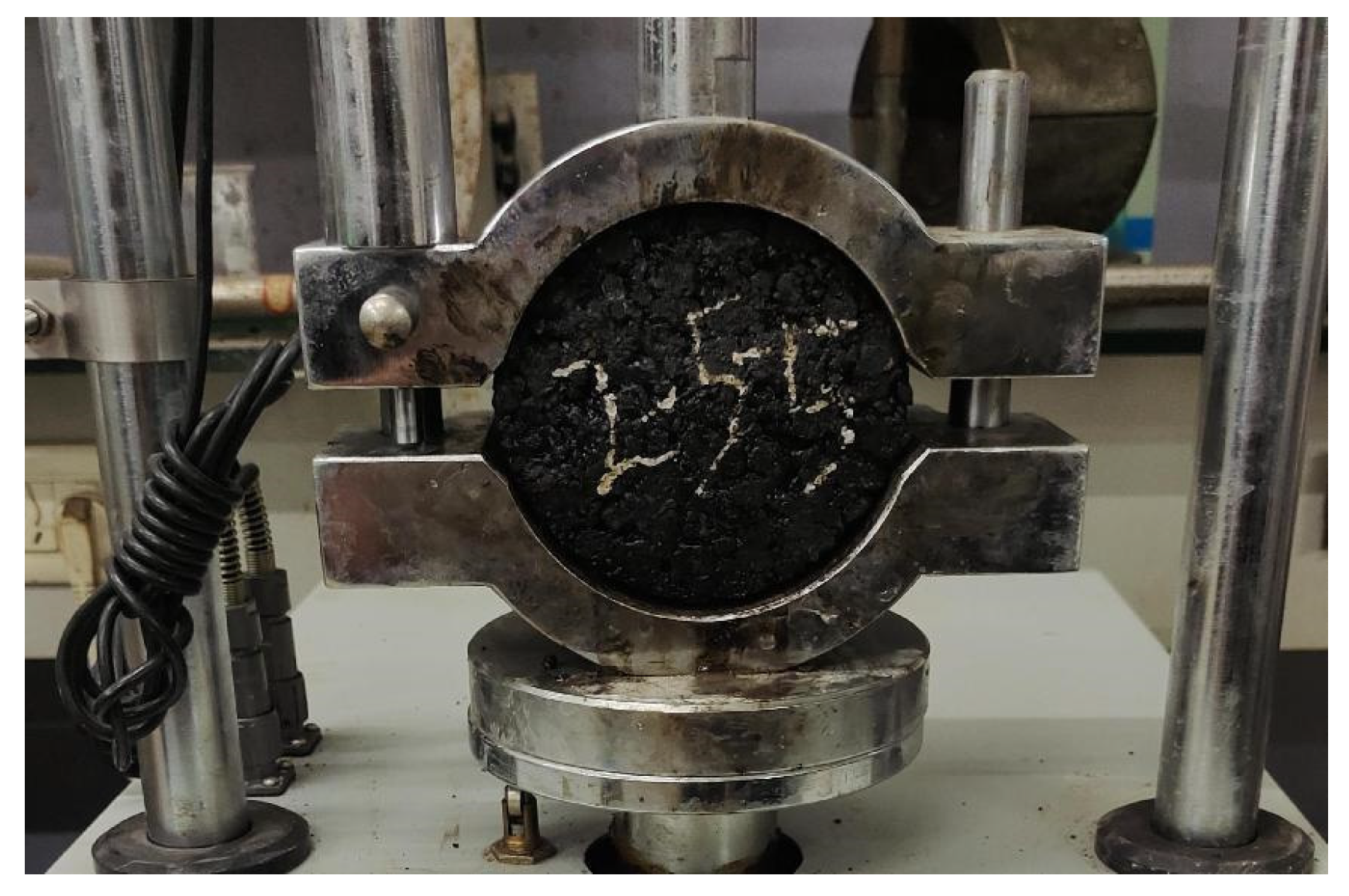
2.4.3. Cantabro Test
- is the immersion scattered losses of the asphalt mixture (%),
- is the mass of specimen before Cantabro testing (g), and
- is the residual mass of specimen after Cantabro testing (g)
2.4.4. Cracking Resistance of Asphalt Mixes
- is the fracture energy of the asphalt mixture (J·m−2),
- is the fracture power of the specimen (J), and
- is the effective area of the cross section of the specimen (m2)
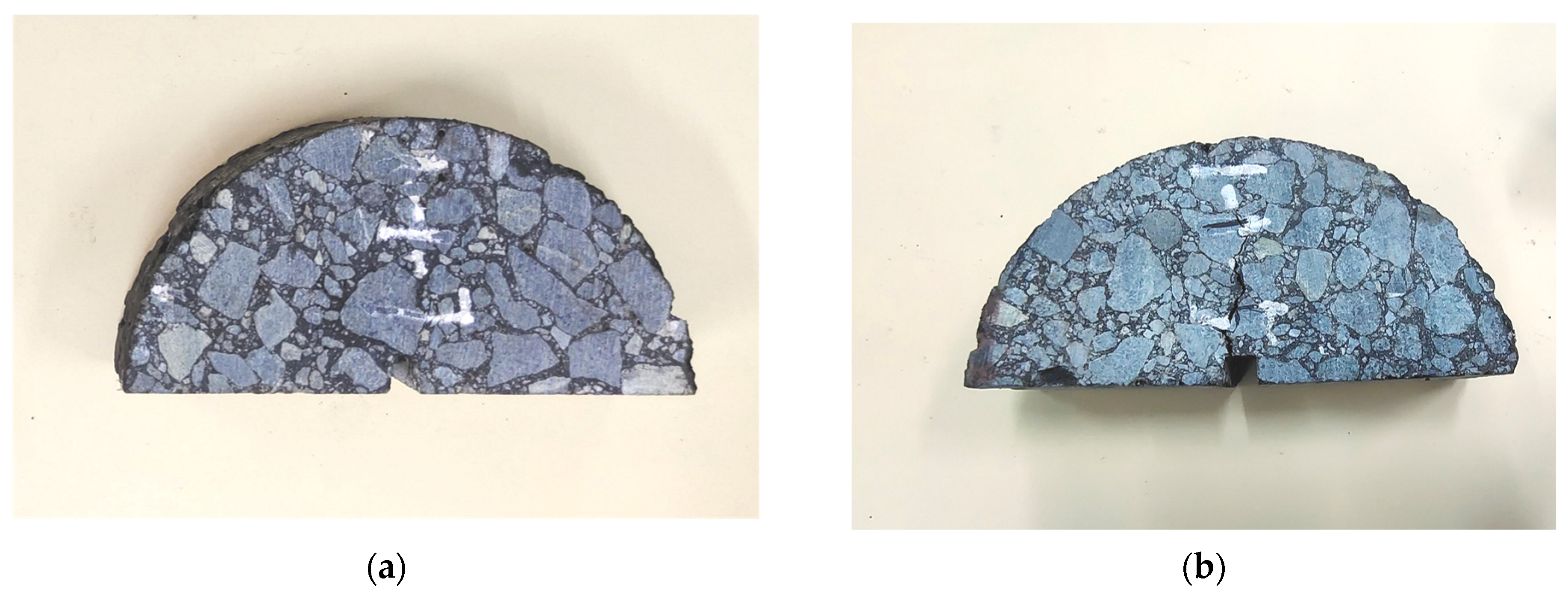
2.4.5. Microwave Healing Test
- is the healing efficiency of each cycle of asphalt mixtures (%),
- is the fracture energy of the first fracture test of asphalt mixtures (J·m−2), and
- is the fracture energy acquired at the x testing cycle, 1 ≤ x ≤ 6 (J·m−2)
3. Results and Discussion
3.1. Chemical Composition of Fillers
3.2. Stability of the Asphalt Mixtures
3.3. Cantabro Test
3.4. Low Temperature Fracture Properties
3.5. Microwave Heating Ability of Asphalt Mixes with Different Filler
3.6. Evaluation of Self-Healing Efficiency
4. Conclusions
- (1)
- Residual Marshall stability and scattering losses: The addition of CGP to asphalt mixes improved the residual Marshall stability and reduced the scattering losses. Specifically, CGP2-100% had the highest residual Marshall stability (96.7%), while CGP1-100% had the lowest scattering losses (4.6%). This enhancement in stability is attributed to the increased interaction between asphalt and basalt due to CGP.
- (2)
- Water stability and adhesion: The water stability and adhesion between asphalt and basalt were improved by incorporating CGP into the mixtures. Both CGP types positively affected water stability, with CGP2 showing a slightly greater residual Marshall stability improvement.
- (3)
- Low-temperature crack resistance: The experimental results indicated that the low-temperature crack resistance of asphalt mixtures was enhanced by the addition of CGP, particularly when the CGP content was 50%. This improved crack resistance contributes to the durability of the asphalt pavement.
- (4)
- Microwave heating capacity: The CGP-enhanced asphalt mixes exhibited improved microwave heating speed compared to limestone powder. CGP’s higher content of silicon oxide and metal oxides, such as alumina and iron oxide, contributed to this effect. The optimal microwave heating temperature was achieved at 30 s.
- (5)
- Self-healing efficiency: The use of CGP in asphalt mixtures improved the fracture energy and microwave self-healing efficiency, especially during the initial four fracture and healing cycles. This indicates that CGP enhances the asphalt mixture’s ability to self-heal, which is crucial for pavement sustainability.
5. Future Recommendation
- (1)
- This experiment only sets three groups of substitution rates to confirm the feasibility of the combined effect of basalt and coal gangue to improve the microwave heating performance of asphalt mixtures. Therefore, in the future, the best replacement rate of coal gangue should be studied, so that the asphalt mixture can achieve the best healing temperature at the fastest speed.
- (2)
- The influence of the distribution uniformity of coal gangue and basalt in the mixture on the electromagnetic field is still unclear, and the relationship between the chemical composition of the filler and the heating rate should be further studied.
- (3)
- In the future, how to reduce the adverse effects of excessive CGP on the low-temperature crack resistance of asphalt mixture should be studied, so as to further improve the utilization rate of coal gangue.
Author Contributions
Funding
Institutional Review Board Statement
Informed Consent Statement
Data Availability Statement
Acknowledgments
Conflicts of Interest
References
- Yang, C.; Wu, S.; Xie, J.; Amirkhanian, S.; Zhao, Z.; Xu, H.; Wang, F.; Zhang, L. Development of blending model for RAP and virgin asphalt in recycled asphalt mixtures via a micron-Fe3O4 tracer. J. Clean. Prod. 2023, 383, 135407. [Google Scholar] [CrossRef]
- Yang, J.; Su, Y.; He, X.; Tan, H.; Jiang, Y.; Zeng, L.; Strnadel, B. Pore structure evaluation of cementing composites blended with coal by-products: Calcined coal gangue and coal fly ash. Fuel Process. Technol. 2018, 181, 75–90. [Google Scholar] [CrossRef]
- Li, D.; Wu, D.; Xu, F.; Lai, J.; Shao, L. Literature overview of Chinese research in the field of better coal utilization. J. Clean. Prod. 2018, 185, 959–980. [Google Scholar] [CrossRef]
- Zhu, X.; Gong, W.; Li, W.; Zhang, C. Fixating lead in coal gangue with phosphate using phosphate-dissolving bacteria: Phosphorus dissolving characteristics of bacteria and adsorption mechanism of extracellular polymer. J. Hazard. Mater. 2023, 458, 131923. [Google Scholar] [CrossRef] [PubMed]
- Zhao, G.; Wu, T.; Ren, G.; Zhu, Z.; Gao, Y.; Shi, M.; Ding, S.; Fan, H. Reusing waste coal gangue to improve the dispersivity and mechanical properties of dispersive soil. J. Clean. Prod. 2023, 404, 136993. [Google Scholar] [CrossRef]
- Liang, Y.; Liang, H.; Zhu, S. Mercury emission from spontaneously ignited coal gangue hill in Wuda coalfield, Inner Mongolia, China. Fuel 2016, 182, 525–530. [Google Scholar] [CrossRef]
- Cao, Z.; Cao, Y.; Dong, H.; Zhang, J.; Sun, C. Effect of calcination condition on the microstructure and pozzolanic activity of calcined coal gangue. Int. J. Miner. Process. 2016, 146, 23–28. [Google Scholar] [CrossRef]
- Mao, N.; Wu, D.; Chen, K.; Cao, K.; Huang, J. Combining experiments and molecular dynamics simulations to investigate the effects of water on the structure and mechanical properties of a coal gangue-based geopolymer. Constr. Build. Mater. 2023, 389, 131556. [Google Scholar] [CrossRef]
- Su, Z.; Li, X.; Zhang, Q. Influence of thermally activated coal gangue powder on the structure of the interfacial transition zone in concrete. J. Clean. Prod. 2022, 363, 132408. [Google Scholar] [CrossRef]
- Peng, W.; Liu, Y.; Lin, M.; Liu, Y.; Zhu, C.; Sun, L.; Gui, H. Toxicity of coal fly ash and coal gangue leachate to Daphnia magna: Focusing on typical heavy metals. J. Clean. Prod. 2022, 330, 129946. [Google Scholar] [CrossRef]
- Lv, Y.; Wu, S.; Li, N.; Cui, P.; Wang, H.; Amirkhanian, S.; Zhao, Z. Performance and VOCs emission inhibition of environmentally friendly rubber modified asphalt with UiO-66 MOFs. J. Clean. Prod. 2023, 385, 135633. [Google Scholar] [CrossRef]
- Gong, X.; Liu, Q.; Wang, H.; Wan, P.; Chen, S.; Wu, J.; Wu, S. Synthesis of environmental-curable CO2-based polyurethane and its enhancement on properties of asphalt binder. J. Clean. Prod. 2023, 384, 135576. [Google Scholar] [CrossRef]
- Cui, P.; Wu, S.; Xiao, Y.; Hu, R.; Yang, T. Environmental performance and functional analysis of chip seals with recycled basic oxygen furnace slag as aggregate. J. Hazard. Mater. 2021, 405, 124441. [Google Scholar] [CrossRef] [PubMed]
- Guan, X.; Chen, J.; Zhu, M.; Gao, J. Performance of microwave-activated coal gangue powder as auxiliary cementitious material. J. Mater. Res. Technol. 2021, 14, 2799–2811. [Google Scholar] [CrossRef]
- Tang, Z.; Li, W.; Ke, G.; Zhou, J.L.; Tam, V.W.Y. Sulfate attack resistance of sustainable concrete incorporating various industrial solid wastes. J. Clean. Prod. 2019, 218, 810–822. [Google Scholar] [CrossRef]
- Xie, J.; Chen, J.; Hu, L.; Wu, S.; Wang, Z.; Li, M.; Yang, C. Preparation, thermochromic properties and temperature controlling ability of novel pellets in ultra-thin wearing course. Constr. Build. Mater. 2023, 389, 131797. [Google Scholar] [CrossRef]
- Liu, S.; Jin, J.; Yu, H.; Gao, Y.; Du, Y.; Sun, X.; Qian, G. Performance enhancement of modified asphalt via coal gangue with microstructure control. Constr. Build. Mater. 2023, 367, 130287. [Google Scholar] [CrossRef]
- Modarres, A.; Rahmanzadeh, M.; Ayar, P. Effect of coal waste powder in hot mix asphalt compared to conventional fillers: Mix mechanical properties and environmental impacts. J. Clean. Prod. 2015, 91, 262–268. [Google Scholar] [CrossRef]
- Modarres, A.; Rahmanzadeh, M. Application of coal waste powder as filler in hot mix asphalt. Constr. Build. Mater. 2014, 66, 476–483. [Google Scholar] [CrossRef]
- Hong, R.-B.; Wu, J.-R.; Cai, H.-B. Low-temperature crack resistance of coal gangue powder and polyester fibre asphalt mixture. Constr. Build. Mater. 2020, 238, 117678. [Google Scholar] [CrossRef]
- Yang, C.; Wu, S.; Cui, P.; Amirkhanian, S.; Zhao, Z.; Wang, F.; Zhang, L.; Wei, M.; Zhou, X.; Xie, J. Performance characterization and enhancement mechanism of recycled asphalt mixtures involving high RAP content and steel slag. J. Clean. Prod. 2022, 336, 130484. [Google Scholar] [CrossRef]
- Sun, Y.; Zheng, L.; Cheng, Y.; Chi, F.; Liu, K.; Zhu, T. Research on maintenance equipment and maintenance technology of steel fiber modified asphalt pavement with microwave heating. Case Stud. Constr. Mater. 2023, 18, e01965. [Google Scholar] [CrossRef]
- Zhu, X.; Cai, Y.; Zhong, S.; Zhu, J.; Zhao, H. Self-healing efficiency of ferrite-filled asphalt mixture after microwave irradiation. Constr. Build. Mater. 2017, 141, 12–22. [Google Scholar] [CrossRef]
- Gallego, J.; del Val, M.A.; Contreras, V.; Páez, A. Heating asphalt mixtures with microwaves to promote self-healing. Constr. Build. Mater. 2013, 42, 1–4. [Google Scholar] [CrossRef]
- Li, C.; Wu, S.; Chen, Z.; Tao, G.; Xiao, Y. Enhanced heat release and self-healing properties of steel slag filler based asphalt materials under microwave irradiation. Constr. Build. Mater. 2018, 193, 32–41. [Google Scholar] [CrossRef]
- Xu, S.; Xueyan, L.; Tabakovic, A.; Schlangen, E. The Prospect of Microwave Heating: Towards a Faster and Deeper Crack Healing in Asphalt Pavement. Processes 2021, 9, 507. [Google Scholar] [CrossRef]
- Jahanbakhsh, H.; Karimi, M.M.; Jahangiri, B.; Nejad, F.M. Induction heating and healing of carbon black modified asphalt concrete under microwave radiation. Constr. Build. Mater. 2018, 174, 656–666. [Google Scholar] [CrossRef]
- Yıldız, K.; Atakan, M. Improving microwave healing characteristic of asphalt concrete by using fly ash as a filler. Constr. Build. Mater. 2020, 262, 120448. [Google Scholar] [CrossRef]
- Li, J.; Yu, J.; Wu, S.; Xie, J. The Mechanical Resistance of Asphalt Mixture with Steel Slag to Deformation and Skid Degradation Based on Laboratory Accelerated Heavy Loading Test. Materials 2022, 15, 911. [Google Scholar] [CrossRef]
- Guo, C.; Zhang, W.; Wang, R.; Qi, S. Enhanced electromagnetic wave absorption by optimized impedance matching: Covalently bonded polyaniline nanorods over graphene nanoplates. J. Mater. Sci. Mater. Electron. 2019, 30, 19426–19436. [Google Scholar] [CrossRef]
- Goel, S.; Garg, A.; Baskey, H.B.; Tyagi, S. Microwave absorption study of low-density composites of barium hexaferrite and carbon black in X-band. J. Sol-Gel Sci. Technol. 2021, 98, 351–363. [Google Scholar] [CrossRef]
- Luo, T.; Xu, L.; Peng, J.; Zhang, L.; Wang, Z. Efficient Preparation of Si3N4 by microwave treatment of solar-grade waste silicon powder. ACS Omega 2020, 5, 5834–5843. [Google Scholar] [CrossRef] [PubMed]
- Aslam, M.A.; Hu, K.; Ding, W.; Hassan, A.; Bian, Y.; Qiu, K.; Qiangchun, L.; Sheng, Z. Dimensionality determined microwave absorption properties in ferrite/bio-carbon composites. Ceram. Int. 2021, 47, 27496–27502. [Google Scholar] [CrossRef]
- Lou, B.; Sha, A.; Li, Y.; Wang, W.; Liu, Z.; Jiang, W.; Cui, X. Effect of metallic-waste aggregates on microwave self-healing performances of asphalt mixtures. Constr. Build. Mater. 2020, 246, 118510. [Google Scholar] [CrossRef]
- Wang, F.; Zhu, H.; Shu, B.; Li, Y.; Gu, D.; Gao, Y.; Chen, A.; Feng, J.; Wu, S.; Liu, Q.; et al. Microwave heating mechanism and self-healing performance of asphalt mixture with basalt and limestone aggregates. Constr. Build. Mater. 2022, 342, 127973. [Google Scholar] [CrossRef]
- Li, J.; Cao, Y.; Sha, A.; Song, R.; Li, C.; Wang, Z. Prospective application of coal gangue as filler in fracture-healing behavior of asphalt mixture. J. Clean. Prod. 2022, 373, 133738. [Google Scholar] [CrossRef]
- Ibrahim, A.; Faisal, S.; Jamil, N. Use of basalt in asphalt concrete mixes. Constr. Build. Mater. 2009, 23, 498–506. [Google Scholar] [CrossRef]
- Qiu, J.; Cheng, K.; Zhang, R.; Gao, Y.; Guan, X. Study on the influence mechanism of activated coal gangue powder on the properties of filling body. Constr. Build. Mater. 2022, 345, 128071. [Google Scholar] [CrossRef]
- Li, F.; Zhao, X.; Zhang, X. Utilizing original and activated coal gangue wastes as alternative mineral fillers in asphalt binder: Perspectives of rheological properties and asphalt-filler interaction ability. Constr. Build. Mater. 2023, 365, 130069. [Google Scholar] [CrossRef]
- Ge, D.; Yan, K.; Ye, F.; Zhao, X. The laboratory performance of asphalt mixture with Amorphous poly alpha olefins (APAO) modified asphalt binder. Constr. Build. Mater. 2018, 188, 676–684. [Google Scholar] [CrossRef]
- Jiang, Q.; Liu, W.; Wu, S. Analysis on factors affecting moisture stability of steel slag asphalt concrete using grey correlation method. J. Clean. Prod. 2023, 397, 136490. [Google Scholar] [CrossRef]
- Serin, S.; Emiroğlu, M.; Gönül, V.E. Investigation of the fracture energy of hot mixtures asphalt incorporating metallic wastes via semi-circular bending test. Constr. Build. Mater. 2021, 300, 124006. [Google Scholar] [CrossRef]
- Gulisano, F.; Gallego, J.; Trigos, L.; Apaza Apaza, F.R. Dielectric characterisation of asphalt mortars for microwave heating applications. Constr. Build. Mater. 2021, 308, 125048. [Google Scholar] [CrossRef]
- Guan, B.; Liu, J.; Zhao, H.; Wu, J.; Yang, F. Investigation of the Microwave Absorption of Asphalt Mixtures Containing Magnetite Powder. Coatings 2019, 9, 813. [Google Scholar] [CrossRef]
- Janu, Y.; Chaudhary, D.; Chauhan, V.; Saini, L.; Patra, M.K. Preparation of Fe–Si–Al intermetallic alloy and their composite coating for EM absorbing application in 6–18 GHz. SN Appl. Sci. 2020, 2, 874. [Google Scholar] [CrossRef]
- Phan, T.M.; Park, D.-W.; Le, T.H.M. Crack healing performance of hot mix asphalt containing steel slag by microwaves heating. Constr. Build. Mater. 2018, 180, 503–511. [Google Scholar] [CrossRef]
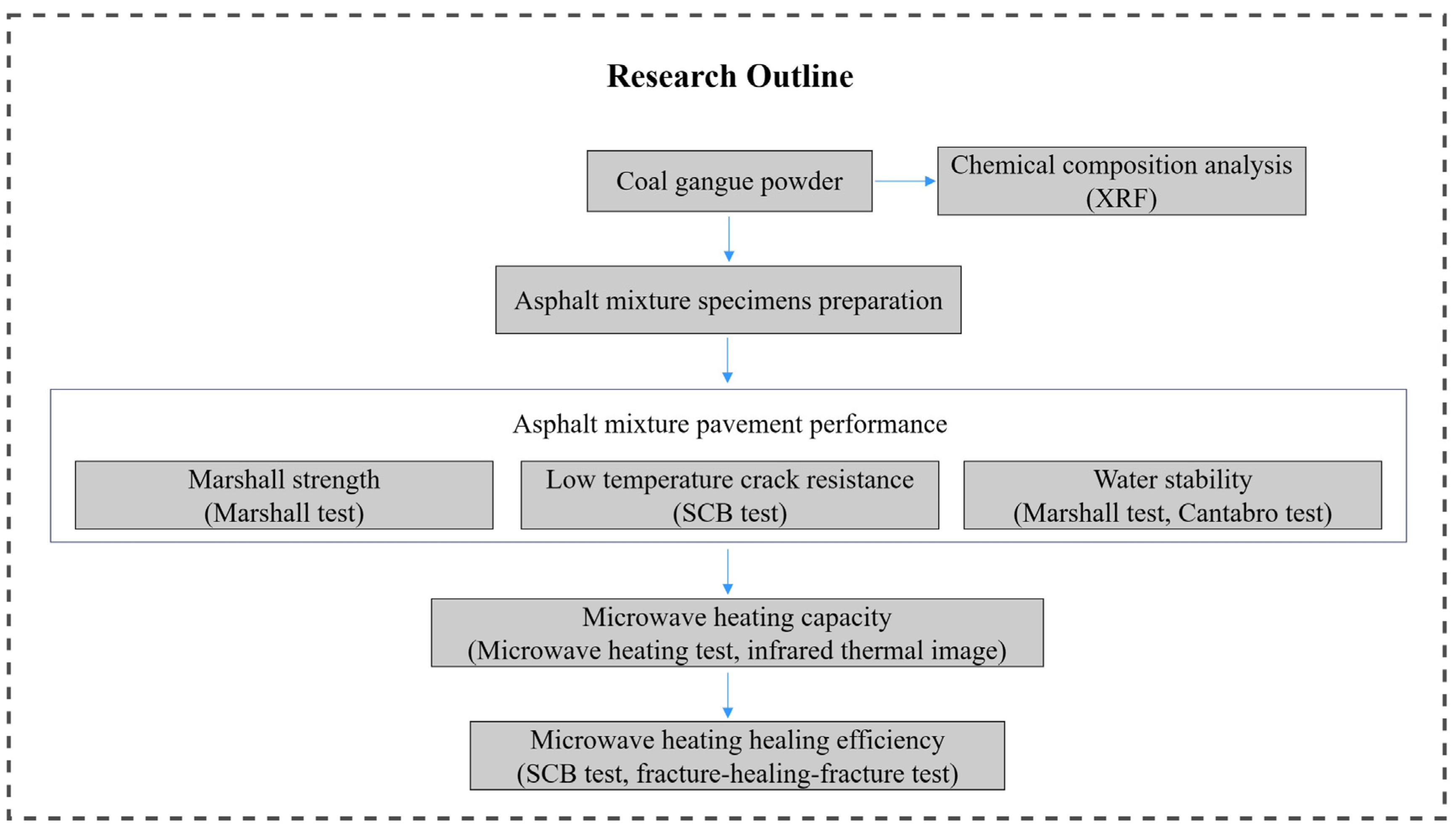

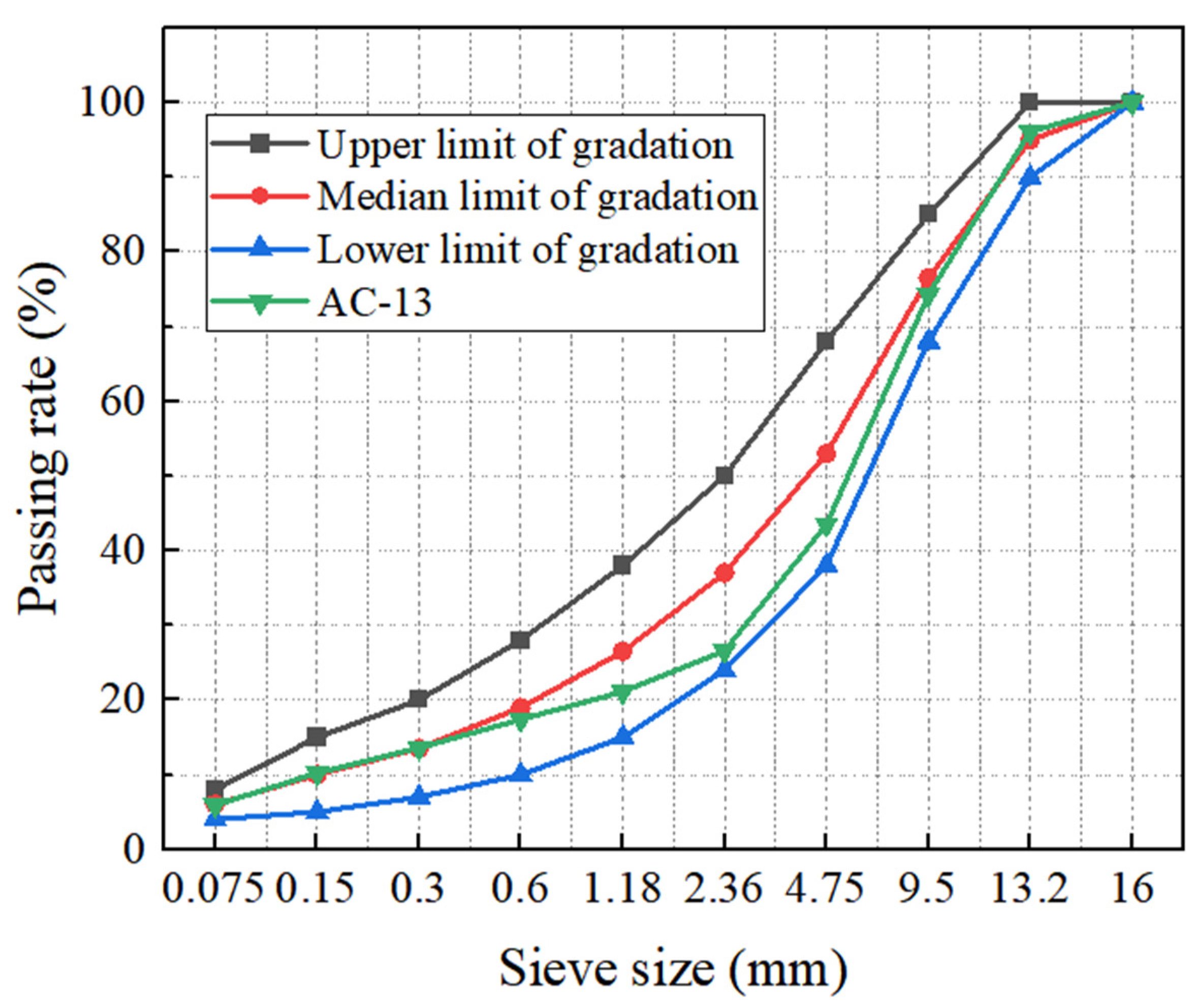
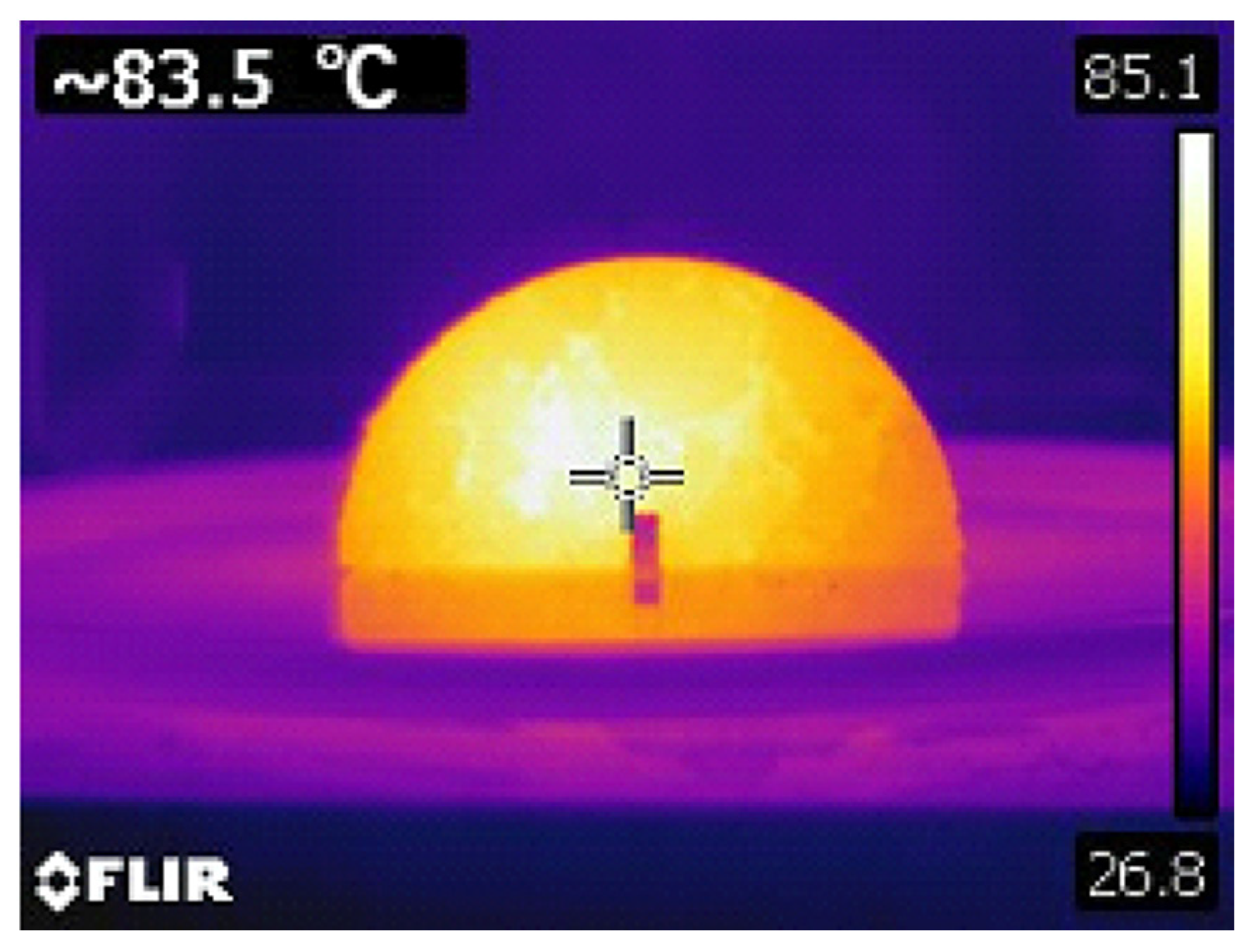
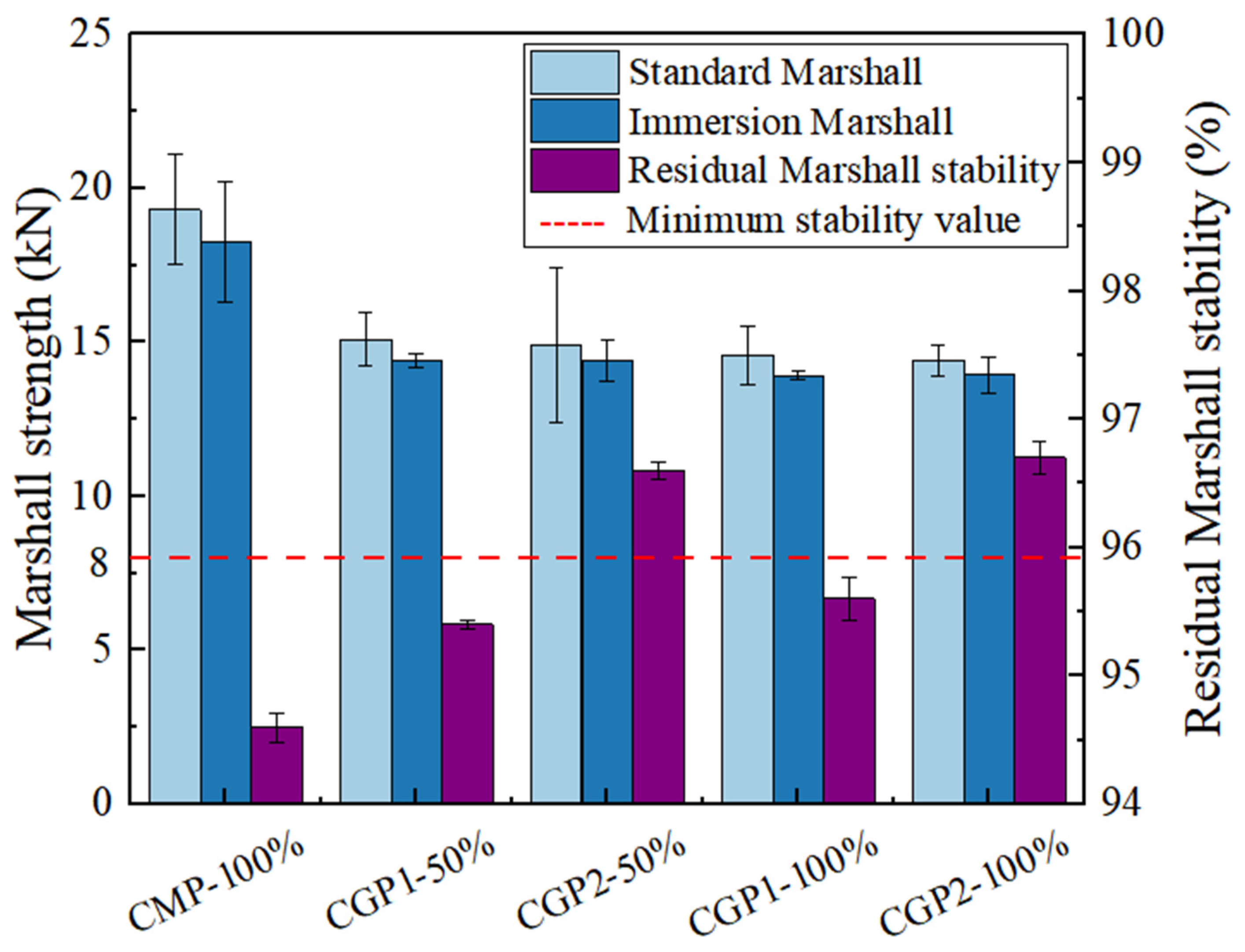
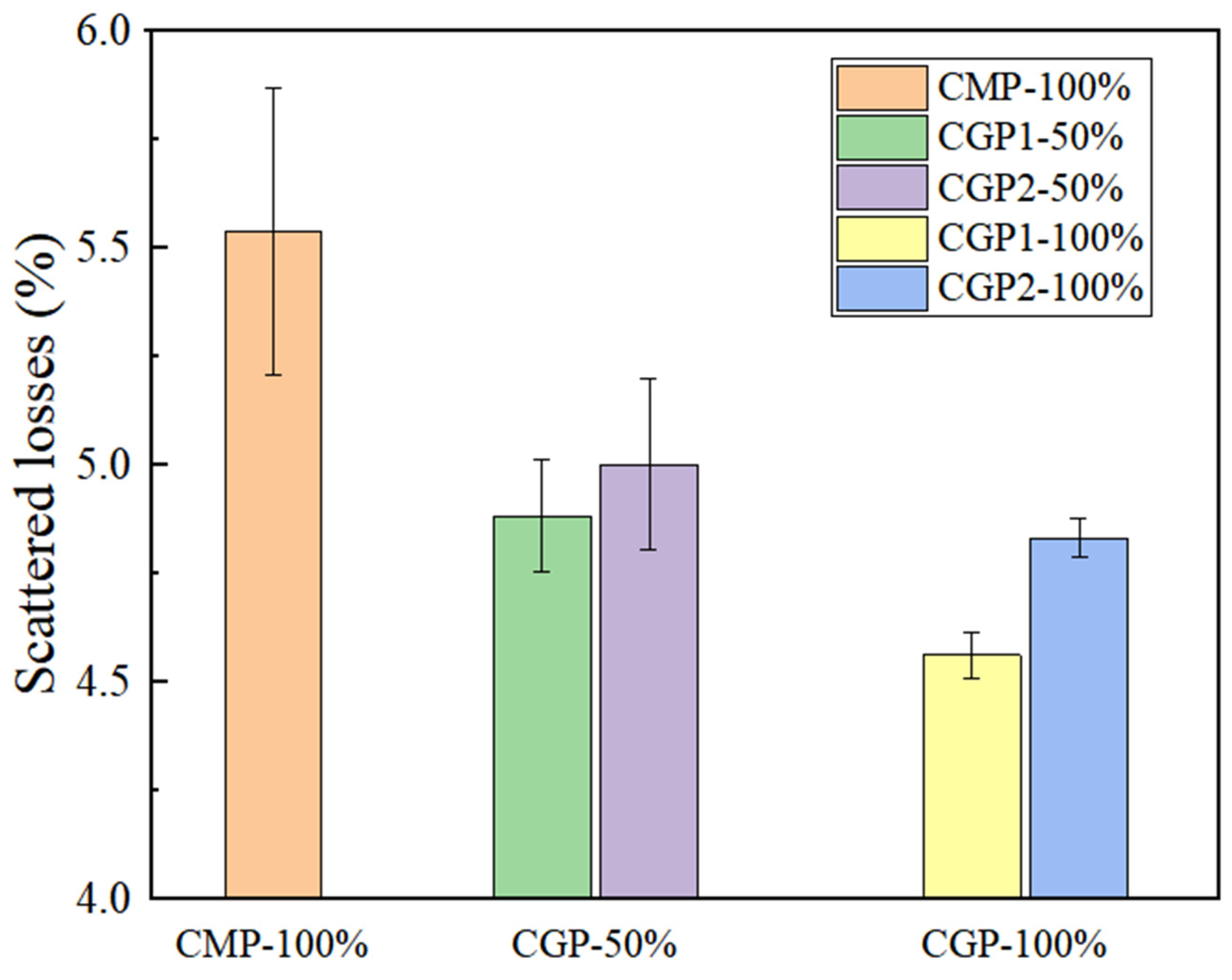
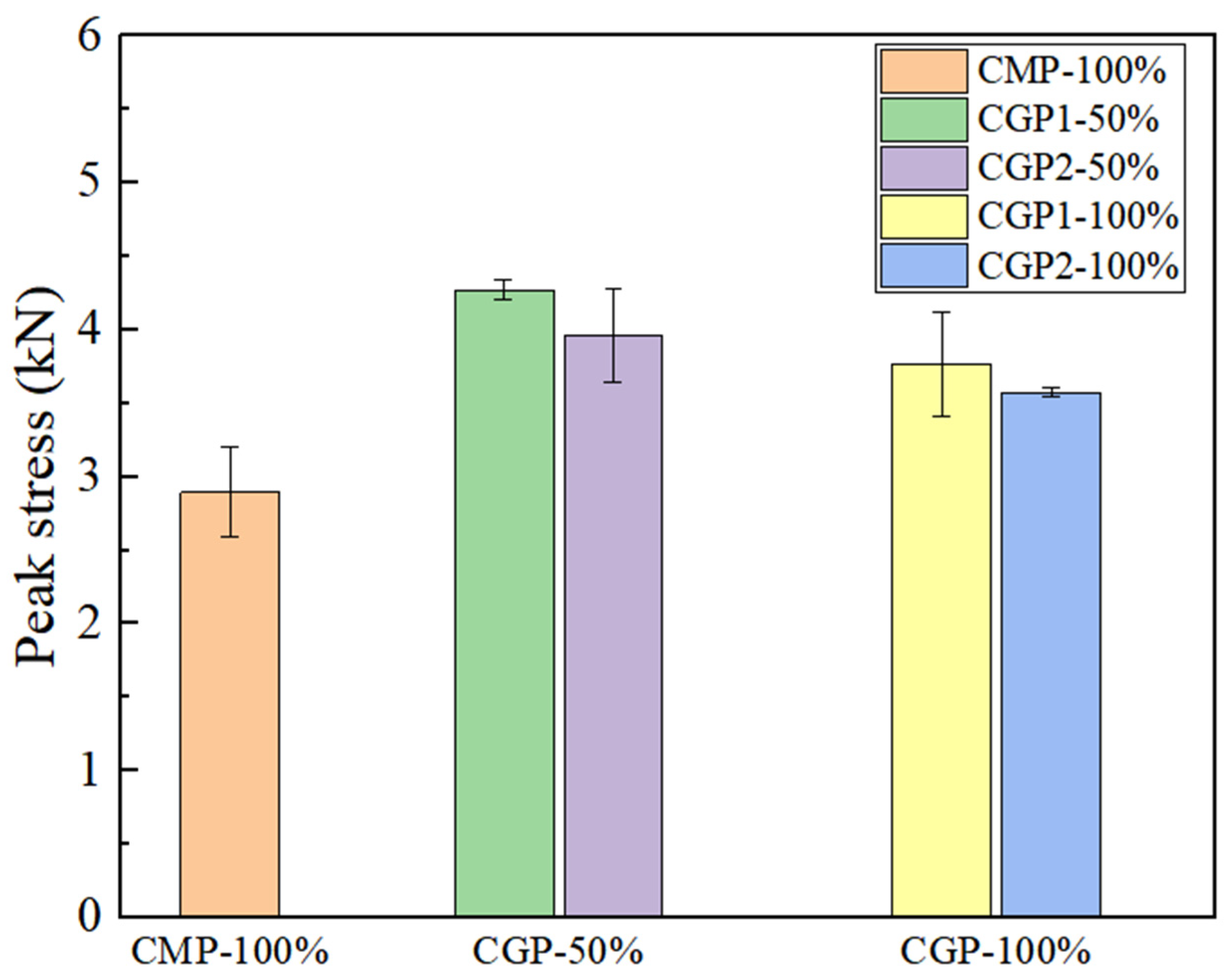

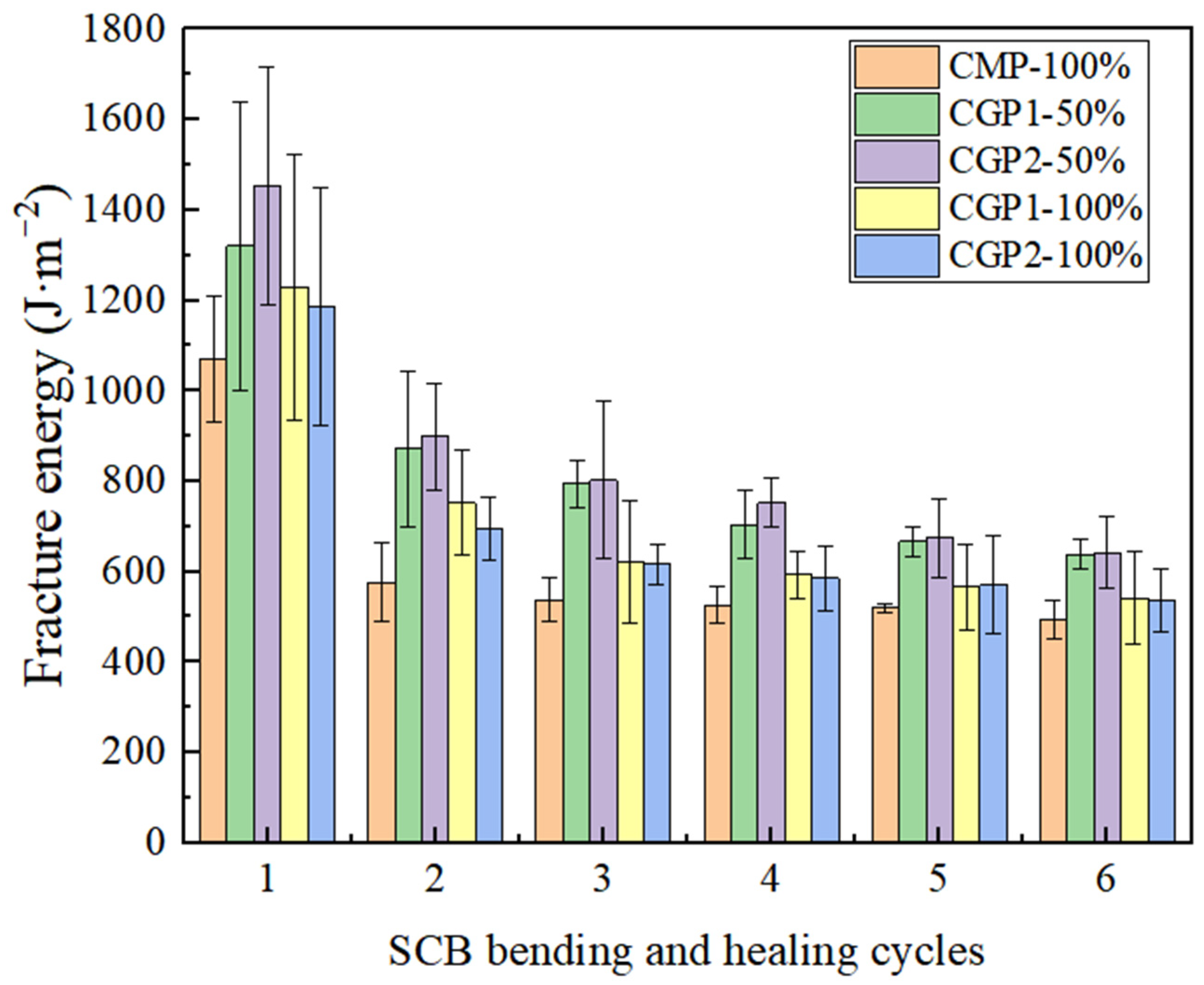
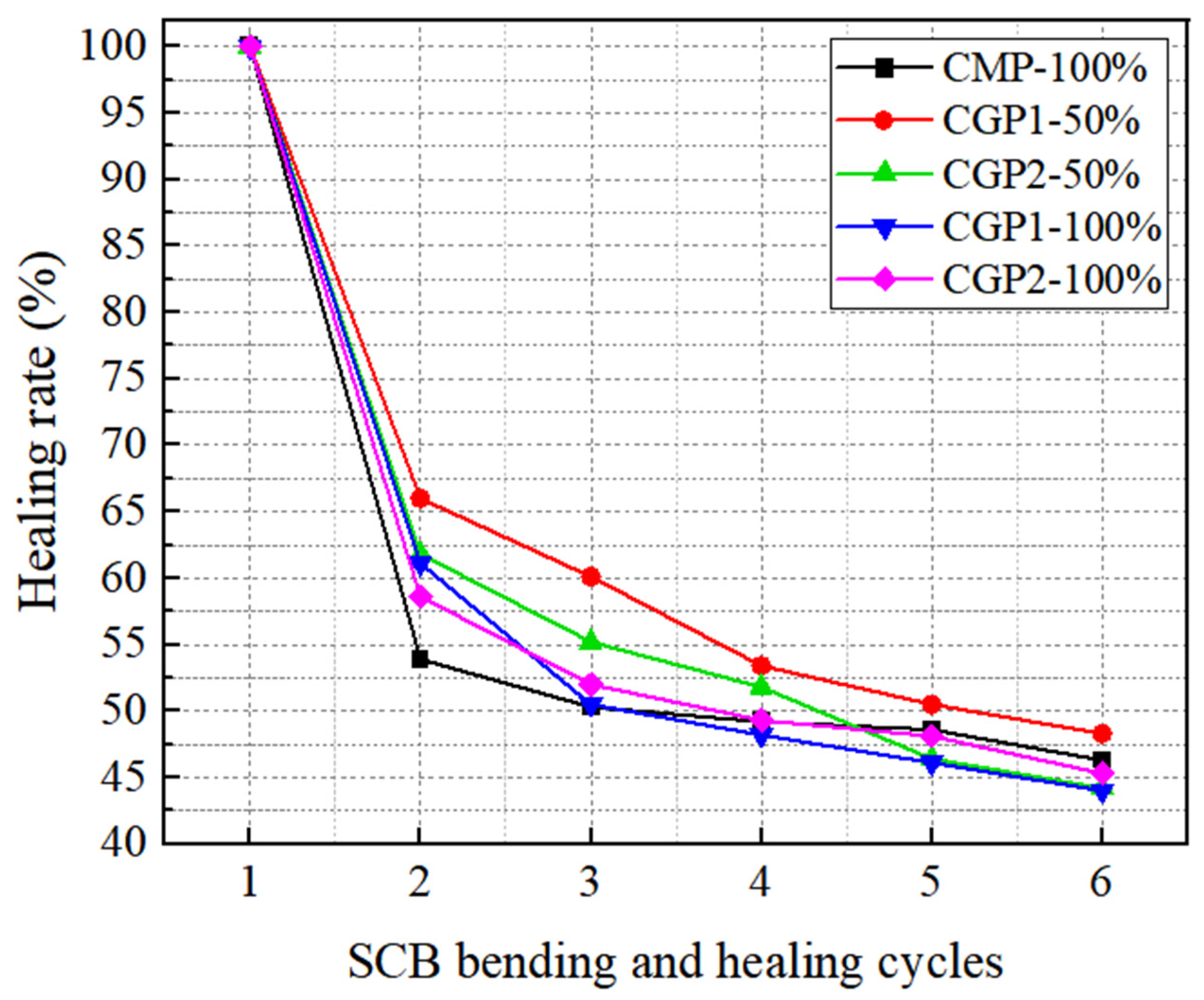
| Item | Values | Test Method | Criteria |
|---|---|---|---|
| Penetration (25 °C, 0.1 mm) | 69.8 | T 0604 | 60~80 |
| Ductility (15 °C, cm) | >100 | T 0605 | >100 |
| Softening point (°C) | 49.5 | T 0606 | ≥46 |
| Item | Values | Test Method | Criteria |
|---|---|---|---|
| Crushing value (%) | 15.8 | T 0316 | ≤26 |
| Water absorption (%) | 0.58 | T 0304 | ≤2.0 |
| Apparent specific gravity (g/cm3) | 2.913 | T 0304 | ≥2.60 |
| Los Angeles wear loss (%) | 19.8 | T 0317 | ≤28 |
| Serial Number | Proportion | Types |
|---|---|---|
| 1 | 100% CMP | CMP-100% |
| 2 | 50% CGP1 + 50% CMP | CGP1-50% |
| 3 | 50% CGP2 + 50% CMP | CGP2-50% |
| 4 | 100% CGP1 | CGP1-100% |
| 5 | 100% CGP2 | CGP2-100% |
| Types | Average Particle Size (nm) | Specific Surface Area (m2/g) | Hydrophilicity Coefficient |
|---|---|---|---|
| CGP1 | 27,730 | 0.44 | 0.75 |
| CGP2 | 20,260 | 0.49 | 0.73 |
| CMP | 57,955 | 0.37 | 0.85 |
| Composition | SiO2 | CaO | MgO | Al2O3 | Fe2O3 | K2O | Na2O |
|---|---|---|---|---|---|---|---|
| CGP1 | 57.74 | 0.20 | 1.04 | 30.58 | 4.31 | 2.76 | 1.10 |
| CGP2 | 53.72 | 2.51 | 0.87 | 26.39 | 5.01 | 2.44 | 1.13 |
| CMP | 0.72 | 52.86 | 2.27 | 0.61 | 0.12 | 0.35 | - |
Disclaimer/Publisher’s Note: The statements, opinions and data contained in all publications are solely those of the individual author(s) and contributor(s) and not of MDPI and/or the editor(s). MDPI and/or the editor(s) disclaim responsibility for any injury to people or property resulting from any ideas, methods, instructions or products referred to in the content. |
© 2023 by the authors. Licensee MDPI, Basel, Switzerland. This article is an open access article distributed under the terms and conditions of the Creative Commons Attribution (CC BY) license (https://creativecommons.org/licenses/by/4.0/).
Share and Cite
Zhang, B.; Gao, X.; Xu, S.; Yang, X.; Tian, Q.; Liu, J. Microwave Heating Healing of Asphalt Mixture with Coal Gangue Powder and Basalt Aggregate. Sustainability 2023, 15, 12986. https://doi.org/10.3390/su151712986
Zhang B, Gao X, Xu S, Yang X, Tian Q, Liu J. Microwave Heating Healing of Asphalt Mixture with Coal Gangue Powder and Basalt Aggregate. Sustainability. 2023; 15(17):12986. https://doi.org/10.3390/su151712986
Chicago/Turabian StyleZhang, Bin, Xu Gao, Shi Xu, Xinkui Yang, Qin Tian, and Jiayi Liu. 2023. "Microwave Heating Healing of Asphalt Mixture with Coal Gangue Powder and Basalt Aggregate" Sustainability 15, no. 17: 12986. https://doi.org/10.3390/su151712986






